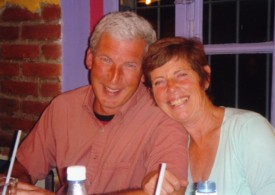Albania and Macedonia – 2011
We 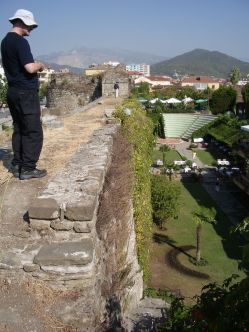 have just returned from 2 weeks exploring Albania and the historic town of Ohrid in Macedonia.
have just returned from 2 weeks exploring Albania and the historic town of Ohrid in Macedonia.
After an overnight stay in Tirana we travelled to visit the fortress in Elbasan. It was our first encounter with many fortresses or castles with very thick walls and all built on strategic high ground. It was also our first encounter with the long relaxed coffee stop. It is amazing how a small cup of espresso or Turkish coffee can be made to last for so long – but in Albania do as the Albanians do!
From Elbasan we headed to the Macedonian border enjoying the countryside and mountains as well as stopping at one of the many colourful roadside stalls to buy fruit. We also noticed many partially buried concrete bunkers near the road. Apparently they are throughout Albania and were provided for protection from enemies by the communist regime (one for every 6 people).
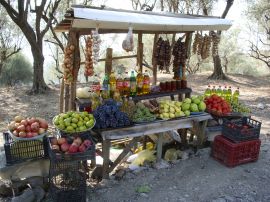
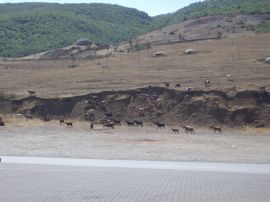
Our destination in Macedonia was the ancient town of Ohrid with a large fortress perched high on the hill. We walked through a beautiful lakeside town before a long climb to St Saul’s fortress. (Long walks up tracks or through narrow streets were to become a key feature of many visits to historic sites most of which also had great views of the surrounding countryside to make the effort worthwhile).
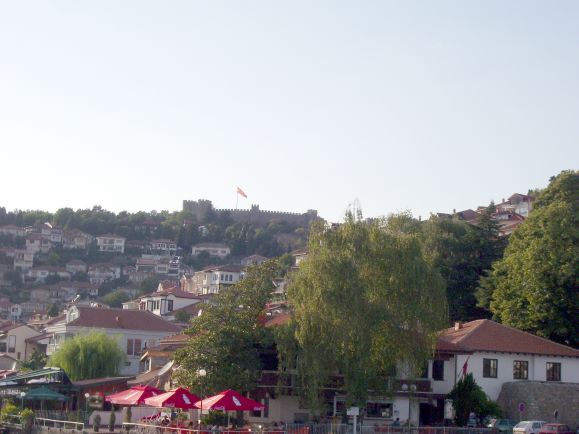
The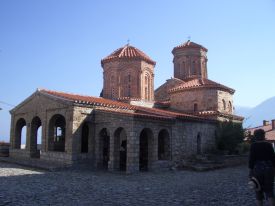 next day we headed for the 15th Century Greek Orthodox Monastery of St Naum arriving early before the majority of visitors so that we could enjoy the Church’s amazing frescos in relative peace and quiet. From St Naum we headed back across the border to Albania and a pleasant drive through agricultural land to reach Korca. Korca was a large rather drab town very reminiscent of the communist era but our hotel was near a large market and a multitude of café-bars. We eventually found a small place where we sampled Byrek, a typical south Albanian pastry made with several layers of dough that has been thinly rolled out by hand ( a bit like filo pastry). Ours were filled with cheese – tasty and very cheap. We
next day we headed for the 15th Century Greek Orthodox Monastery of St Naum arriving early before the majority of visitors so that we could enjoy the Church’s amazing frescos in relative peace and quiet. From St Naum we headed back across the border to Albania and a pleasant drive through agricultural land to reach Korca. Korca was a large rather drab town very reminiscent of the communist era but our hotel was near a large market and a multitude of café-bars. We eventually found a small place where we sampled Byrek, a typical south Albanian pastry made with several layers of dough that has been thinly rolled out by hand ( a bit like filo pastry). Ours were filled with cheese – tasty and very cheap. We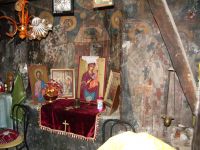 visited several local sites including a church dating back to the 12th or 13th century. During the communist era Albania had been declared an atheist state and many churches had been destroyed or quite commonly used as store houses! It was quite amazing how many survived including the icons and frescos. We also visited the first school in Albania which was established in the 1890s and an archaeological museum before enjoying a traditional Albanian meal -plate after plate of ‘mezze’ followed by veal and fries (!) or grilled vegetables and rounded off with a dish of yoghurt, honey and cherries.
visited several local sites including a church dating back to the 12th or 13th century. During the communist era Albania had been declared an atheist state and many churches had been destroyed or quite commonly used as store houses! It was quite amazing how many survived including the icons and frescos. We also visited the first school in Albania which was established in the 1890s and an archaeological museum before enjoying a traditional Albanian meal -plate after plate of ‘mezze’ followed by veal and fries (!) or grilled vegetables and rounded off with a dish of yoghurt, honey and cherries.
Early next morning we set off for the long (in time) drive through high mountains to Permeti. The scenery was very beautiful and despite the narrow, windy, steep and not very smooth roads the journey was enjoyable especially a coffee stop (despite witnessing the butchering of a sheep) and a lunch stop high in the mountains where we sat in the relative cool enjoying local food and wine. 
Permeti was quiet when we arrived but by evening it had come alive with lots of people out walking, children playing, and men sitting chatting, playing dominoes, backgammon or chess as well as many older men sitting in the cafes and bars drinking coffee – we did not notice any older women in the cafes or bars.
The next morning we set off for the village of Benja. 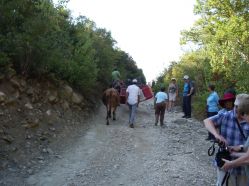
Parking our bus at the bottom of a long stony track passable by pedestrians, donkeys and only the most robust of small vehicles, we set out on the mile long walk to the village. We visited  an ancient orthodox church where, as is typical for Albania, men and women ‘sit’ on separate sides of the church in odd shaped stalls.
an ancient orthodox church where, as is typical for Albania, men and women ‘sit’ on separate sides of the church in odd shaped stalls.
After a visit to the village school comprising 5 pupils with ages ranging from 7 through to 14, we were invited to visit to a local family who showed us their home and provided welcome coffee, chocolates, figs and peaches. We returned to the bus and a visit to some hot springs (this time only about 1/3 mile walk from where the bus parked. We rounded off the day with a visit to a small preserves factory (cottage industry and all by hand) which also made Raki (a fierce white spirit).
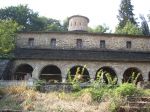 The next morning our immersion in steep climbs continued as we walked to the village of Leuba to visit the 11th Century St Mary’s Church which had survived the communist era being used as a store shed! Inside was amazing with walls and ceiling covered in frescos. Unfortunately, they all need a lot of restoration.
The next morning our immersion in steep climbs continued as we walked to the village of Leuba to visit the 11th Century St Mary’s Church which had survived the communist era being used as a store shed! Inside was amazing with walls and ceiling covered in frescos. Unfortunately, they all need a lot of restoration.
.
Our next overnight stop was the town of Gjiorkaster. The old part of the town was on a hill and much more beautiful than the drab sprawling newer part in the valley. Unfortunately, the cobbled roads were so steep and narrow that we had to walk the last 1/2 mile! At 5pm, when at least it had started to cool down, we set off for a folk museum set in the former communist dictator Enver Hoxha’s house. Then followed a climb through the streets and up many steps to the impressive Castle. The origin of the castle goes back 2500 years and was in effect a walled city.

The following day we set off for the archaeological site at Butrint, which Annie had visited in 2007 on a day trip from Corfu. On our way we stopped for coffee at a water spring known as ‘Blue Eye’. 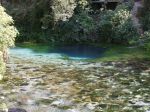
This is a natural phenomenon where clear blue water bubbles up through a pool more than fifty metres deep. Arriving at Butrint at the hottest time of the day was perhaps not the best idea but we strolled around the site which dates back to the 4th Century BC and is one of the most remarkable archaeological sites in the Adriatic Sea region.
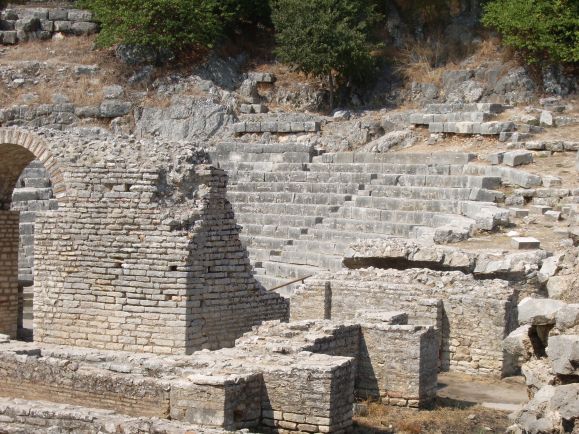
Our destination that evening was the seaside town of Saranda. Not the best or cleanest of beaches but obviously a popular destination. We had dinner sitting in the open air high on a hill top overlooking the town and across the sea to Corfu. The views were quite amazing.
Leaving Saranda we drove along the coast and visited Ali Pasha’s Castle which was amazingly intact and with very thick walls and many rooms.

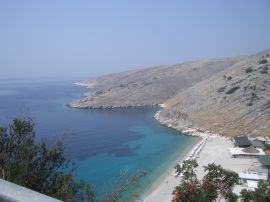
We continued along the coast passing one or two beautiful beaches before starting a very long climb on a road just like those in the Swiss Alps on and on and up and up we went passing the odd roadside stall and small town. One stall selling honey had a very new Aston Martin car parked by it. In fact an interesting observation about Albania, where cars have only really become common in the last 10 years, is that quite a few are very expensive Mercedes with foreign number plates suggesting to many that some (or even a lot) were perhaps stolen in the UK, France or Italy. Old Mercedes are certainly the most popular cars in Albania– even driving schools use them.
Anyway, back to our journey and a two night stay in the Llogara National Park high in the hills. There were a few hotels but no shops or banks. It was great to experience the cooler  mountain air and enjoy walking including yet another uphill walk this time to a battlefield from 48BC. We had just returned to the hotel when we experienced the first rain of our trip. Rain is probably an understatement it was torrential!
mountain air and enjoy walking including yet another uphill walk this time to a battlefield from 48BC. We had just returned to the hotel when we experienced the first rain of our trip. Rain is probably an understatement it was torrential!
The next day we headed for the archaeological site of Apollonia. The site is very large dating back to the 6th Century BC and declining in 3rd Century AD with only a small percentage excavated so far.


We toured the agora, theatre and church areas with an archeologist from the site as our guide. Unfortunately, the open air part of our visit was curtailed by rain.
We also had rain 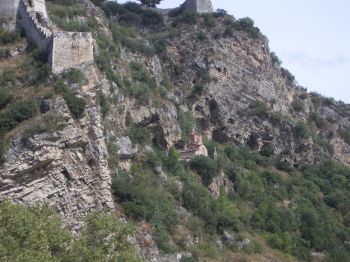
the next evening when we were staying in the well-preserved Ottoman city of Berat. The town has a beautiful medieval inhabited citadel district on top of the hill. In the photograph on the right, you can just make out the beautiful Church of St Mary’s on the hillside below the Citadel walls. Further along the hillside is a very old town nestling on the hillside. The roads are so narrow and steep that vehicles cannot travel on most of them. We enjoyed walking through the town and visiting a Folk museum which provided a fascinating insight into how wealthy 
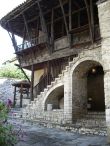 Albanian families lived around two hundred years ago. After a day exploring old and modern Berat we boarded our bus for the drive up a very steep road to the Citadel. Once inside the walls we visited 4 of the many medieval Orthodox churches before going to look at the city from the walls of the Citadel. It was dark as we negotiated our way back along the uneven cobbled paths- tricky.
Albanian families lived around two hundred years ago. After a day exploring old and modern Berat we boarded our bus for the drive up a very steep road to the Citadel. Once inside the walls we visited 4 of the many medieval Orthodox churches before going to look at the city from the walls of the Citadel. It was dark as we negotiated our way back along the uneven cobbled paths- tricky.
The next 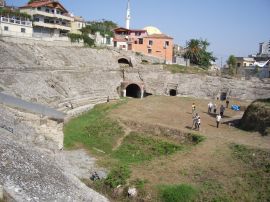 morning the sun shone as we set off for the coastal town of Durres. Here we visited the museum (brilliant) and a partially excavated amphitheatre (even better) seating between 15 and 18000. They have still to demolish some houses so that they can dig down to reach part of the site but it looks as though it will be fantastic once the excavations are complete in many years time. From Durres we travelled to the historic town of Krujë perched high in the hills. We changed our modern deluxe room with a view of a building site for a basic room with a balcony and fantastic view of the castle and the valley.
morning the sun shone as we set off for the coastal town of Durres. Here we visited the museum (brilliant) and a partially excavated amphitheatre (even better) seating between 15 and 18000. They have still to demolish some houses so that they can dig down to reach part of the site but it looks as though it will be fantastic once the excavations are complete in many years time. From Durres we travelled to the historic town of Krujë perched high in the hills. We changed our modern deluxe room with a view of a building site for a basic room with a balcony and fantastic view of the castle and the valley. 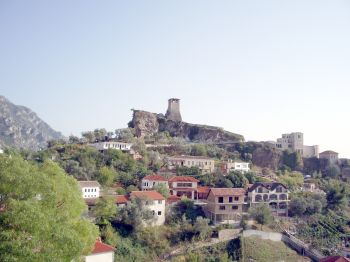
After a short rest we set off through the narrow cobbled bazaar and then climbed to a wonderful modern museum where we learned about Skanderbeg the national hero of Albania. In the early 15th century Krujë was conquered by the Ottoman Empire, but then recaptured in 1443 by Skanderbeg who successfully defended it against three Ottoman sieges until his death in 1468. From the modern museum we visited our third folk museum of the trip. Whilst there was much in common with the previous houses, there were regional variations worth seeing. Our final climb took us to the castle tower for the panorama. We could see Italy in the distance, Macedonia over the mountains and a vista that stretched on and on –brilliant and worth the climb. As the sun set, we made our way back down to our hotel and a leisurely supper including local wine. Albania produces a lot of wine for local consumption and most of what we sampled during our visit was reasonable but it was all cheap (£1.33 for a large glass in a restaurant).
So on to our final destination Tirana. Tirana is large, noisy and not a place we warmed to.  However, on our last evening we visited Petrela Castle, one of the oldest structures in Tirana and about 45 minutes drive from the centre. Although most of the castle is Byzantine dating from between the 11th and 14th centuries the tower in the centre was built in the 5th century AD and is now capped by a (very) small restaurant. As usual we had a long climb up cobbled paths to reach the castle but were treated to great views. On the way back we stopped for probably our best meal in Albania – lots of local food and wine – and a fitting end to a really good two weeks.
However, on our last evening we visited Petrela Castle, one of the oldest structures in Tirana and about 45 minutes drive from the centre. Although most of the castle is Byzantine dating from between the 11th and 14th centuries the tower in the centre was built in the 5th century AD and is now capped by a (very) small restaurant. As usual we had a long climb up cobbled paths to reach the castle but were treated to great views. On the way back we stopped for probably our best meal in Albania – lots of local food and wine – and a fitting end to a really good two weeks.
We returned to the UK with good memories of a country steeped in history. We found the people welcoming, the food delicious, the countryside hilly and quite beautiful but the seaside areas to be generally less attractive. The only negative observation was that, as in so many developing countries, the ubiquitous plastic bags and cans littered the ground. The communist era certainly stagnated development and involvement with the world beyond its borders, but the country is now emerging from its tormented past and has so much to offer travellers interested in exploring history and culture (and food). If your interests coincide with ours we would certainly recommend a visit before tourist numbers increase.

